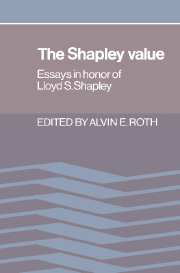Book contents
- Frontmatter
- Contents
- Preface
- 1 Introduction to the Shapley value
- I Ancestral papers
- II Reformulations and generalizations
- III Coalitions
- 11 Coalitional value
- 12 Endogenous formation of links between players and of coalitions: an application of the Shapley value
- IV Large games
- V Cost allocation and fair division
- VI NTU games
11 - Coalitional value
Published online by Cambridge University Press: 13 October 2009
- Frontmatter
- Contents
- Preface
- 1 Introduction to the Shapley value
- I Ancestral papers
- II Reformulations and generalizations
- III Coalitions
- 11 Coalitional value
- 12 Endogenous formation of links between players and of coalitions: an application of the Shapley value
- IV Large games
- V Cost allocation and fair division
- VI NTU games
Summary
Solutions of games with coalition structures
The study of coalition structures has been seriously explored only recently. Coalition structures are already implicit in the von Neumann—Morgenstern (1944) solutions; because of their internal and external stability the solutions isolate those stable coalition structures that generate the final payoffs. This is to be contrasted with the extensive subsequent literature on the core in which “blocking” is merely a criterion for accepting or rejecting a proposed allocation; no specific coalition structure is implicit in any core allocation. Analysis of games in partition function form (see, for example, Thrall and Lucas 1963) is a more explicit way of studying restrictions on coalition structures. Perhaps the best-studied class of games whose core of a coalition structure was investigated is the “central assignment games” (see, for example, Shapley and Shubik 1972; Kaneko 1982; and Quinzii 1984). This class includes the particular case of the “marriage games” (Gale and Shapley 1962) and is closely related to the various variants of the “job matching games” (see, for example, Crawford and Knoer 1981; Kelso and Crawford 1982; Roth 1984a,b). The nonemptiness of the core of the coalition structure of these games is an important result, to which we return in Section 3.
- Type
- Chapter
- Information
- The Shapley ValueEssays in Honor of Lloyd S. Shapley, pp. 155 - 174Publisher: Cambridge University PressPrint publication year: 1988
- 3
- Cited by

